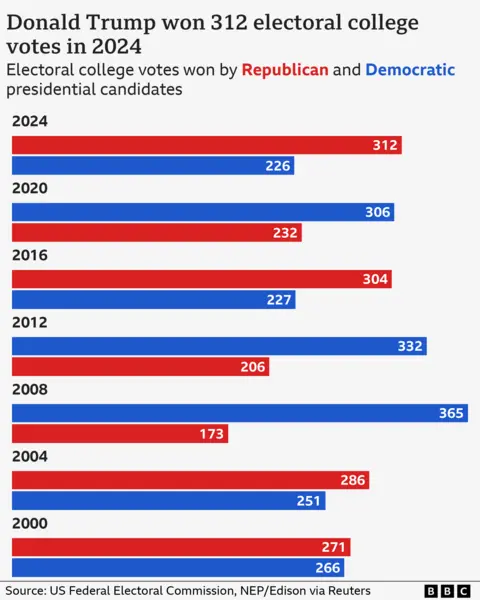The data show that ultimately Trump’s victory in the elections was not as strong as he and his allies make it out to be
The Republican president-elect Donald Trump he beat his Democratic opponent in all seven critical states Kamala Harrisalso won both houses of Congress with himself saying that his election victory gave him an “unprecedented and powerful” mandate to rule.
However, the data present a different reality than the one he and his allies convey, since they show how his victory was not so strong, according to his analysis BBC.
His communications director, Steven Chung, called it an “overwhelming” victory. However, it emerged this week that his share of the vote has fallen below 50% as counting continues.
Trump’s language speaks of landslide victories, said Chris Jackson, senior vice president in the U.S. group at polling firm Ipsos, but in reality it was a few hundred thousand votes in key areas that gave Trump the impetus to return to the White House, he says .
Most voters chose someone other than Trump
With 76.9 million votes, Trump won, according to CBS News. That means she got more votes than Kamala Harris (74.4 million) or any other candidate. No Republican has accomplished that feat since 2004. But as the vote count continues in some U.S. precincts, his share of the vote has fallen below 50 percent, and he is not expected to close that gap as counting continues in places where Democrats are ahead, like California.
This was also the case in 2016, when Trump beat Hillary Clinton to the presidency despite losing the popular vote – having scored only 46% of the total vote.
In 2024, Trump’s victory can be considered an improvement compared to his last win eight years ago. But Trump can’t say he won an absolute majority. To do that, he would have to have won more than 50%, as all winners have done in the last 20 years – except for Trump in 2016.
For that reason, his claim to a historic mandate “can be overlooked,” says Chris Jackson of polling firm Ipsos, who said the language of Trump and his supporters is a tactic used to “justify the sweeping actions they plan to take once they are in control of the government.”
His victory in the electoral college was resounding
By a different metric, Trump’s victory over Harris in 2024 looks more comfortable. He won 312 votes in the US Electoral College compared to 226 for Harris. And that’s the number that really matters. In the USA, voters from 50 different states vote. . Both candidates hoped to reach the magic number of 270 electoral votes to win a majority in the college. Trump’s 312 is better than Joe Biden’s 306 and surpasses both Republican victories since George W. Bush. But it’s far short of Barack Obama’s 365 in 2008, or Obama’s 332 re-election wins, or Ronald Reagan’s colossal 525 in 1984.
Trump leads by just over 230,000 votes in Michigan, Pennsylvania and Wisconsin, according to the latest CBS numbers. All three states were campaigned by both parties.
If just over 115,000 voters in those three states had chosen Harris, then she would have received enough electoral votes to win the presidency. Although the number sounds large, it is actually a drop in the ocean compared to the 150 million voters.
Second highest number of votes – behind Biden in 2020
There is also another measure by which one can look at Trump’s victory, which is to look at the number of votes he received. The 76.9 million it has collected so far is the second highest tally in American history.
It is important to remember that the US population, and thus the electorate, is constantly growing. The more than 150 million people who voted in the US this year are more than double the number of 74 million who went to the polls in 1964.
This makes comparisons over time difficult. But it was only four years ago that the record was achieved.
Biden won 81.3 million votes on his way to the White House in 2020 – a year of historic voter turnout when Trump was again the candidate.
Although Republicans made significant breakthroughs in 2024, Democrats also failed to win over voters, said Jackson, who put the trend down to Americans’ desire to return to “2019 prices” after a years-long cost-of-living squeeze.
“The real story is Harris’ inability to mobilize the people who voted for Biden in 2020,” he said.
Source :Skai
With a wealth of experience honed over 4+ years in journalism, I bring a seasoned voice to the world of news. Currently, I work as a freelance writer and editor, always seeking new opportunities to tell compelling stories in the field of world news.











